Teachers and Students
 Title: LANGUAGE DEVELOPMENT OF INTERNATIONALLY ADOPTED CHILDREN
Title: LANGUAGE DEVELOPMENT OF INTERNATIONALLY ADOPTED CHILDREN
Submission code: VP_001
Author: Georgios Moutsinas
Abstract: The present paper discusses issues of student diversity, focusing on the language development of Internationally Adopted Children (IAC). The adoption of foreign children constitutes an international social phenomenon of high frequency, due to demographic, sociopolitical and humanitarian reasons. The sociolinguistic shortcomings and traumatic experiences of IAC have been assumed to pose risks of developmental delay on their interpersonal relationships, emotions and particularly on their linguistic skills, affecting respectively their in-school and extracurricular life. Consequently, the purpose of the subject paper is to outline the linguistic development of IAC. For this reason, a literature review strategy is followed, collating and summarizing the findings of the twenty (20) most recent (2000-2015) relevant empirical studies, conducted at European and international level, investigating internationally adopted preschoolers, primary school aged children and adolescents. In all three categories, the IAC’s language development seems peculiar; however, it is observed that it does not differ regarding certain stages applicable in typically developing monolingual children, acquiring relatively quickly the current second first language (English or French), although considered a vulnerable social group. Nevertheless, specific language deficits of receptive and productive language delay are identified, by majority in oral speech, which fall outside the sphere of pathology; they depend on IAC’s small age at adoption, as well as on their linguistic and adverse psychological and emotional background, in conjunction with the multiple idiosyncratic effects of the school and family environment. In conclusion, until preschool age, by majority indigenous children’s language level is reached or approached by IAC. Lastly, owing to the ambiguous and sometimes conflicting findings and methodological limitations of the studies reviewed, further investigation of the sociopolitical, demographic and economic parameters of IAC’s language acquisition is expected, in order to benefit both theoretically and on the level of educational practice.
Keywords: Language development, internationally adopted children.
File Extension: Movie Clip (.mpg)
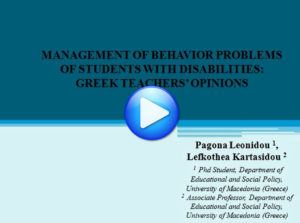 Title: MANAGEMENT OF BEHAVIOR PROBLEMS OF STUDENTS WITH DISABILITIES: GREEK TEACHERS’ OPINIONS
Title: MANAGEMENT OF BEHAVIOR PROBLEMS OF STUDENTS WITH DISABILITIES: GREEK TEACHERS’ OPINIONS
Submission code: VP_131
Author: Pagona Leonidou & Lefkothea Kartasidou
Abstract: Effective classroom management is necessary for all teachers and facilitators. Not only does classroom management include how the teacher or facilitator delivers the curriculum, but also how the students interact with the teacher and with peers in the classroom, and extends into the classroom environment in which students learn as well as socialize. Approaches aimed at improving school and classroom environments, including reducing the negative effects of disruptive or distracting behaviors, can enhance the chances that effective teaching and learning will occur, both for the students exhibiting problem behaviors and for their classmates. Special and general educators believe that there is a positive correlation between emotional intelligence growth and school performance, but they do not seem to be aware of the control they themselves have on the teaching structure and its effect on the students (e.g. Giavrimis & Papanis, 2009). The purpose of this survey was to determine teachers’ perceptions of their confidence in classroom behaviour management, as well as the use and usefulness of such strategies. Teacher Classroom Management Questionnaire (TSQ: Webster-Stratton, 2012) was used as an instrument in the particular study. In total, 200 special (98) and general (102) educators from primary and secondary schools have participated in this survey. The sample was randomly selected from cities in Central and North Greece. The results show that, in general, teachers state ‘somehow confident’ in managing present and future behavior problems in class and also in promoting social and emotional skills’ growth. Only 30% of the teachers questioned, though, have applied a social and emotional learning program in their class. They state that they often use prevention strategies, such as discipline plan, clear rules etc because they consider them important. Concerning positive or negative behavior management strategies, they seem to prefer using them almost to the same extent, because they consider them almost equally important and necessary for the classroom management, except for the inappropriate strategies such as singling out child or group for misbehavior. Finally, they seek support and solutions mostly among their peers rather than the relevant literature. Despite their confidence in using appropriate strategies, regular training in classroom management would improve their choice of behaviour management techniques (Giallo & Little, 2003).
Keywords: Behaviour management strategies, teachers’ opinions, students with behavioural problems.
File Extension: Windows Media Audio/Video file (.wmv)
Projects and Trends
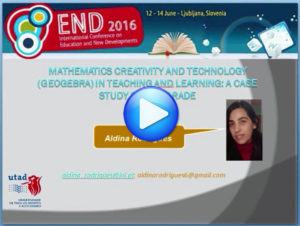 Title: MATHEMATICS CREATIVITY AND TECHNOLOGY (GEOGEBRA) IN TEACHING AND LEARNING: A CASE STUDY OF 9TH GRADE
Title: MATHEMATICS CREATIVITY AND TECHNOLOGY (GEOGEBRA) IN TEACHING AND LEARNING: A CASE STUDY OF 9TH GRADE
Submission code: VP_052
Authors: Aldina Rodrigues, Paula Catarino, Ana Paula Aires & Helena Campos
Abstract: Recent studies have shown the advantages of using dynamic geometry contexts in the mathematics’ classroom, in learning of mathematics. More studies like have shown that mathematics students’ creativity can be promoted through new teaching methodologies that means implementing tasks, where the students has a more active and independent role. In general, the students they have difficulties in the learning of mathematics and difficulties of teachers to motivate them to learning. The contexts using technology to facilitate the learning of mathematical concepts and promoting to creativity in students.The attempt to minimize this problem related was the motivation that led to this investigation. This study addressed whether a teaching experience performed with dynamic geometry software (Geogebra), which analyzed the conceptions of students about the creativity concept and evaluated the mathematics creativity by dimensions in reasoning processes of these students, to solve tasks of exploration and investigation in theme Functions. The study sample was one class of 19 students (12-15 years old) the 9th grade of a public school in the northern region of Portugal. The methodology used in this study was qualitative, following a design case study and the instrument for data collection was the questionnaire survey and mathematics tasks, implemented in mathematics’ class at the beginning and end of teaching experience, in the school year 2014/2015. In the data processing it was included the analysis of the responses of students in the questionnaire survey and in tasks, using content analysis by formulating categories of analysis. Analyzing the results, it can be concluded that participants associating creativity and mathematics creativity concepts the “To create do something new and different”. This teaching experience showed that the fluency and flexibility were the dimensions of the most representative mathematical creativity by varying in student’s responses the different questions of the task. To point out that this teaching experience contributed to the development of mathematical creativity of study when students use technology in solving mathematical tasks.
Keywords: Creativity, mathematics, teaching and learning, dynamic geometry software.
File Extension: Windows Media Audio/Video file (.wmv)
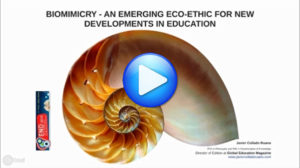 Title: BIOMIMICRY: AN EMERGING ECO-ETHIC FOR NEW DEVELOPMENTS IN EDUCATION
Title: BIOMIMICRY: AN EMERGING ECO-ETHIC FOR NEW DEVELOPMENTS IN EDUCATION
Submission code: VP_092
Authors: Javier Collado-Ruano
Abstract: The nature of this paper is to study and reflect upon the “Global Citizenship Education” (GCED) and the “Sustainable Development Goals” (SDGs) proposed in the post-2015 Development Agenda led by the United Nations. The work has a transdisciplinary methodology and biomimetic approach with the intentionality to strengthen the links between human education and sustainability in the planet Earth. The concept of biomimicry seeks to understand the operating principles of life in nature with the goal to mimic them and reformulate the current human production systems in a sustainable way with the biosphere. Biomimicry is a key topic in the natural and social sciences because it promotes problem-resolution, cross-disciplinary team-performance, and wellbeing. The study is focused in the panoramic picture provided by the Big History discipline, in order to understand the ecosystems´ principles of coevolution on Earth. As result, the study shows many sustainable principles that human systems must mimic to achieve the SDGs. In conclusion, it is a research that seeks to integrate the eco-ethics as a pedagogical practice in the implementation of the GCED.
Keywords: Sustainable development goals, sustainability, biomimicry, Big History, co-evolution.
File Extension: Windows Media Audio/Video file (.wmv)
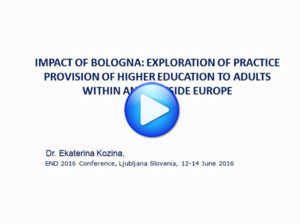 Title: IMPACT OF BOLOGNA: EXPLORATION OF PRACTICE PROVISION OF HIGHER EDUCATION TO ADULTS WITHIN AND OUTSIDE EUROPE
Title: IMPACT OF BOLOGNA: EXPLORATION OF PRACTICE PROVISION OF HIGHER EDUCATION TO ADULTS WITHIN AND OUTSIDE EUROPE
Submission code: VP_109
Authors: Ekaterina Kozina
Abstract: This paper discusses the impact of international and European reforms of Higher Education (HE) systems – especially the Bologna Process – on higher education provision for adults within Europe and; in the Russian Federation. Over the past decade the European Commission has encouraged Member States to make lifelong learning the basic principle underlying education and training, and within this framework to develop the Adult Learning sector (as set out in the “Action Plan on Adult Learning”, 2007). Opening up higher education to those who have not previously engaged in studies at this level, including adults, is seen as crucial in this context. Flexible provision has been identified as one of the main elements needed in order to attract more non-traditional learners into higher education while overcoming barriers faced by this group of learners. In spite of this, progress on the benchmark for adult learning participation has been low. The paper presents some findings from one of the strands of the large scale completed project “Opening Higher Education to Adults”, covering a representative range of the 25 countries (20 European and 5 non-European). At the time of author’s work at Higher Education Research Centre, the work was completed on 3 country studies on the adult higher education provision – UK Ireland and one non-European country (Russia) within this international collaborative project. The overall objective of this work was to collect information contributing to a knowledge base which will inform a number of future activities within the framework of European Cooperation on Adult Learning Policy. In this paper specifically, present the findings on Russia as a country case – mapping and analysis of recent developments in Russia with regard to quality approaches in the field of Adult Learning. I report on the work which involved a mix of desk-based research and analysis, as well as fieldwork, few expert interviews and fact-finding visits: a mapping of national regional policies, frameworks/legislation with regard to quality approaches, innovative teaching methods and other developments in the field of Adult Learning. I will also discuss some of the issues and challenges which are specific to the adult learning sector in relation to assuring quality of its providers and provision. Methodology: The project was a comprehensive study on the factors impacting on the participation of adults in higher education and on the flexible delivery of higher education programmes and learning provisions for adult learners. The Research methodology has specifically focused on 25 country studies. The broad themes of the individual country studies included conducting the background research on the: definitions of ‘adults’ in HE and specification of target group of adult learners in HE; regulatory issues and policies at national, regional and institutional level (e.g. access and admission to HE, funding of HEIs, student grants/loans); the barriers for opening HE to adults (historical and contextual); the drivers for the enhancement of adult learners in HE (e.g. labour market policy, educational policy, demographic change). The work also involved a mix of desk-based research and analysis, as well as fieldwork, few expert interviews and fact-finding visits. In this paper I present the findings of the research work and conclude with the outcomes of the project and map the important factors that facilitate or inhibit participation of adults in Higher Education. In particular, I will map the important factors that facilitate or inhibit the participation of adults in HE; will describes models from higher education institutions (HEIs) in Russia, based on the completed case study, that are engaged in adult education; identify the types of flexible learning, including open and distance learning which are conducive for good adult learner performance and; will provide an example of good practice, selected from 5 non-European countries, with a specific reference to Russia.
Keywords: Mature students, Bologna process, adult learning, access to HE; innovative learning methods.
File Extension: Windows Media Audio/Video file (.wmv)
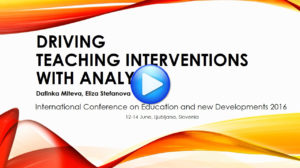 Title: DRIVING TEACHING INTERVENTIONS WITH ANALYTICS
Title: DRIVING TEACHING INTERVENTIONS WITH ANALYTICS
Submission code: VP_122
Authors: Dafinka Miteva & Eliza Stefanova
Abstract: The research described in this article aims to study the analytics impact on the process of teaching. A short review of analytics evolution is presented, making a retrospect to the time of Greek philosopher Aristotle and his works on Analytics. Some physical analytics methods through the years are mentioned before reaching the contemporary digital world where the modern Learning Analytics concepts, methods and tools are discussed. The paper goes deep into using the information technology achievements in measuring, collecting, analyzing and reporting of data about learners during the educational process. Key methods and popular computer tools for digital analysis and Educational Data Mining are threshed out. Software functionalities are compared and the most sought-after features for a LA product are defined. Finally the paper includes some challenges and further works for creating effective Learning Analytics tools and components integrated in a learning environment.
Keywords: Learning Analytics, Information Technologies, review, Big Data, education.
File Extension: Windows Media Audio/Video file (.wmv)
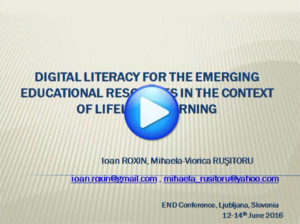 Title: DIGITAL LITERACY FOR THE EMERGING EDUCATIONAL RESOURCES IN THE CONTEXT OF LIFELONG LEARNING
Title: DIGITAL LITERACY FOR THE EMERGING EDUCATIONAL RESOURCES IN THE CONTEXT OF LIFELONG LEARNING
Submission code: VP_182
Authors: Ioan Roxin & Mihaela-Viorica Rusitoru
Abstract: Digital technologies occupy an increasing part of our private and public life. It would seem that educational performances may be improved thanks to digital tools. Implicitly, in a context of lifelong learning, the appropriation of digital skills is a long-standing debate. In this article, we formulated the hypothesis that digital literacy becomes a key element for lifelong learning and completes the traditional methods of teaching. In order to test this hypothesis, we used a mixed methodology. The results of the research confirmed that, simultaneously, digital literacy is linked with the core competencies, involves a set of educational disciplines and influences the lifelong learning by developing several elements such as creativity, distributed cognition, judgement, pooling knowledge, social awareness and citizenship.
Keywords: Digital literacy, digital skills, core competencies, lifelong learning.
File Extension: Windows Media Audio/Video file (.wmv)
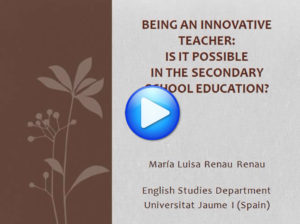 Title: BEING AN INNOVATIVE TEACHER: IS IT POSSIBLE IN THE SECONDARY SCHOOL EDUCATION?
Title: BEING AN INNOVATIVE TEACHER: IS IT POSSIBLE IN THE SECONDARY SCHOOL EDUCATION?
Submission code: VP_216
Authors: María Luisa Renau Renau
Abstract: The University Master’s Degree for Secondary Education, Vocational Training and Language Teaching at the University Jaume I (Castellón, Spain) allows students to consider what education is during the educational period involved. It is open to students from various degree courses, many of which are not related to teaching, although all students have had their own educational experience in the past. It is necessary to shape the idea of teaching that each of us has about a thoughtful teacher who does not act on impulse or intuition – or at least not always – and who incorporates reflection in their professional activity, together with the appropriate skills and knowledge. The present research is implemented in the subject: ‘Teaching Innovation and Introduction to Educational Research’ in the specialty of Language and Literature and Language Teaching of this Master degree. 45 students are involved in this subject (24 belong to the branch of English and the remaining 21 belong to the Spanish branch). The importance of this subject in the formation of secondary school teachers is the need that teachers have to confront and respond to the changes that have occurred in recent decades in society. All these aspects are discussed in this subject from three general units: innovation, research and evaluation, which is taught from a generic and multidisciplinary perspective in the first half and applied specifically in the field of specialty in the second part. As part of the subject´s assessment, the students are asked to work in groups in order to write a research proposal between 3000-4000 words, divided into two main parts: (i) theoretical background (definition of innovative teaching, main trends and authors and some examples of innovative projects), (ii) students define the innovative tool/resource they have chosen (e.g. blog, wiki, Webquest, forum, etc), then, they have to design a didactic unit with 3/4 tasks (describing target pupils, methodology, contents, competences, objectives). In this paper, we analyse the virtual resources chosen and explained in their proposals and reflect their feelings and opinions about the implementations of these new technologies in a real secondary school classroom. Result show that these innovative tools can help secondary school teachers to enrich and improve the teaching/learning method by supporting the traditional method but, by no means, substituting it, however not all our students think about the possibility of implementing them in a class.
Keywords: Secondary school education, master´s degree students, innovative resources.
File Extension: Windows Media Audio/Video file (.wmv)
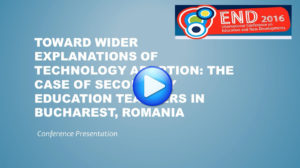 Title: TOWARD WIDER EXPLANATIONS OF TECHNOLOGY ADOPTION: THE CASE OF SECONDARY EDUCATION TEACHERS IN BUCHAREST, ROMANIA
Title: TOWARD WIDER EXPLANATIONS OF TECHNOLOGY ADOPTION: THE CASE OF SECONDARY EDUCATION TEACHERS IN BUCHAREST, ROMANIA
Submission code: VP_262
Authors: Andrei Ogrezeanu & Cezar Scarlat
Abstract: A variety of theoretical models of technology adoption by individuals have been advanced including Innovation Diffusion Theory (IDT), Theory of Reasoned Action (TRA), Technology Acceptance Model (TAM), Social Cognitive Theory (SCT) and Theory of Planned Behavior (TPB). TAM has general been the most influential and arguably has shaped important aspects of research. Its preferred variables, perceived usefulness and perceived ease of use, have usually been favored as principal direct effects on technology adoption, often other variables being demoted, a priori, to the role of antecedents. TAM has also come under recent criticism for having had an oversimplifying effect on research. This paper aims to widen the universe of possible explanations of ICT use and intentions of use. We do so by means of a comprehensive study of direct effects on them, where most explanatory variables proposed by the main theories in the field are tested for simultaneously in a many-variable statistical study. The study is based on a survey of 845 secondary education teachers primarily from Bucharest, Romania. Our regression analysis (OLS) results show that: 1) a high percentage (60%) of variance is explained in both models; 2) the results of the use and intentions models are quite different; main relevant direct explanatory variables for use express capability, opportunity and social influence: ICT access, ICT skills, and observability; while the main explanatory variables for intentions are computer enjoyment, compatibility, perceived usefulness, image and self-efficacy denoting psychological motivations; 3) TAM variables, perceived usefulness and perceived ease of use, don’t play a very important role (the former is significant in the model of intentions only, and the later not at all), suggesting that broader models of direct determinants of technology adoption need to be constructed.
Keywords: Technology adoption, information and communications technology, secondary education, teachers, Romania.
File Extension: Windows Media Audio/Video file (.wmv)
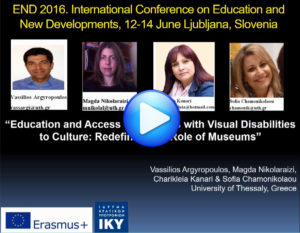 Title: EDUCATION AND ACCESS OF STUDENTS WITH VISUAL DISABILITIES TO CULTURE: REDEFINING THE ROLE OF MUSEUMS
Title: EDUCATION AND ACCESS OF STUDENTS WITH VISUAL DISABILITIES TO CULTURE: REDEFINING THE ROLE OF MUSEUMS
Submission code: VP_275
Authors: Vassilios Argyropoulos, Magda Nikolaraizi, Charikleia Kanari & Sofia Chamonikolaou
Abstract: Museums in the 21st century have redefined their role in the society with the development of a wide educational and social role and in the context of an “audience centered” approach. In this perspective museums seek to remove different barriers of access in order to improve their relationship with their audiences, to promote educational opportunities to different people and to contribute to social inclusion and social cohesion. The present paper refers to a European project entitled “Bridging the Gap between Museums and Individuals with Visual Impairments” (BaGMIVI) which aims to support museums to develop various practices in order to enhance the access and inclusion of people with visual disabilities into their context and content with emphasis to schoolchildren with visual disabilities. A crucial factor for the access of schoolchildren with visual disabilities to museums is the training of museums staff not only in issues of visual disabilities but also in contemporary issues in inclusive education and differentiation. Issues of the development of a syllabus for museums staff training, the main axes and the thematic areas of the syllabus as well as the training course that took place in the participating museum in Greece are presented in this paper. Based on the experience of this training course, the feedback from museum staff and the development of accessible and differentiated museums programmes the authors argue that museums staff training in the above issues is very important not only for the improvement of knowledge about disability but also for the positive attitudes and the development of educational activities which can respond to the needs and characteristics of school children with visual disabilities.
Keywords: Students, visual disability, museums, museum staff training, inclusion.
File Extension: Windows Media Audio/Video file (.wmv)
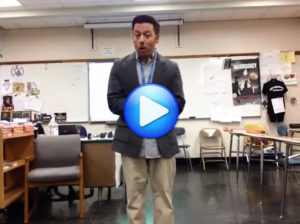 Title: THE ROCK STAR SOCRATIC SEMINAR WITH LIVE DIGITAL FEEDBACK
Title: THE ROCK STAR SOCRATIC SEMINAR WITH LIVE DIGITAL FEEDBACK
Submission code: W_127
Authors: Kurt C. Schuett
Abstract: Participants will discuss the specific educational differences between “being an advocate” versus “advocacy” across local-to-international social, political, and economic platforms. The Inner/Outer Socratic Seminar will form the backbone of group discussion in addition to real-time, ongoing digital observations/conversation. Teachers participating in this presentation will take away detailed teaching methods that will introduce a hands-on, multi-tiered Socratic Seminar that can be transitioned from teacher control to complete student-centered management over the course of an entire year. Instructional methods that underpin deep reading & writing analysis of informational texts with collaborative participant-driven speaking and listening techniques will be shared both digitally and via hard copy. This seminar style can easily segue itself into something philanthropic, expanding beyond the traditional brick and mortar classroom.
Keywords: Socratic, seminar, methodology, digital, authenticity.
File Extension: MP4 Video (.mp4)
Teaching and Learning
 Title: EFFECT OF ORTHOGRAPHY ON ENGLISH AND ARABIC READING AND SPELLING IN LEBANESE FIRST GRADES: A COMPARATIVE PILOT STUDY
Title: EFFECT OF ORTHOGRAPHY ON ENGLISH AND ARABIC READING AND SPELLING IN LEBANESE FIRST GRADES: A COMPARATIVE PILOT STUDY
Submission code: VP_035
Authors: Ahmad Oweini & Katia Hazoury
Abstract: This study hypothesized that poor Arab readers should perform better in English (non-phonetic, orthographic language) decoding than in Arabic (phonetic-orthographic) because they rely on the orthographic route to compensate for their phonological deficits. To test this hypothesis, a group of Lebanese bilingual first graders comprised of normally achieving and poor readers and spellers were given tasks of decoding, orthographic discrimination, encoding and visual tests in both English and Arabic. Results of this pilot comparative study across ability and languages showed significant differences between good and poor readers on tasks of single word decoding and encoding and on the visual tests in Arabic. No significance was found between both groups on decoding of English words, orthographic discrimination and visual tests in English, suggesting that the deficient phonological skills of poor readers would hinder their word recognition in Arabic, yet their visual-orthographic ability would compensate for these deficits when reading English words. Further, different orthographies seem to require different cognitive skills. Implications for Arabic reading instruction are provided.
Keywords: Arab; Lebanese; reading; spelling; orthography; phonology.
File Extension: MP4 Video (.mp4)
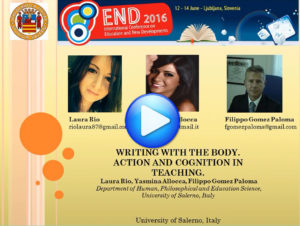 Title: WRITING WITH THE BODY. ACTION AND COGNITION IN TEACHING
Title: WRITING WITH THE BODY. ACTION AND COGNITION IN TEACHING
Submission code: VP_186
Authors: Laura Rio, Jasmina Allocca & Filippo Gomez Paloma
Abstract: Until a few years ago, the prevailing position in cognitive science was to consider the human body a brain accessory (Borghi & Iachini, 2004). During the last ten years this position was, however, overturned by a multitude of experiments and publications that have highlighted the importance played by the physical body in cognitive processes: it is claimed, in fact, that cognition is embodied (Embodied Cognition, Caruana & Borghi, 2013) and that it depends also by features of corporeal type. The student, using his body as the main tool for apprehension and communication, acquires knowledge and skills that, otherwise, would remain inaccessible; it allows him to participate actively with the world around him, giving him the opportunity to learn through experience, exploration, the relationship with the others, using his body to express, interpret and to know: that’s how it is really possible to realize the circular process of the body-action-cognition (Gomez Paloma, 2009). Starting from this analysis, the aim of the research was the acquisition of reading and writing skills using the educational method (Josiane Jeannot Method, Neri A., 2005), which bases its activities mainly on the use of the body, and to verify its effectiveness through the results achieved and the enjoyment rating perceived (PACES-it, Carraro, Young and Robazza, 2008). The research involved 69 children of 6-7 years divided into three classes and for a period of four months. The Jeannot method has been adopted only in two classes, in order to observe the difference of the achieved results, and in the same classes it was also given the enjoyment test adapted to the children’s age. The results obtained at the end of the meetings were very clear: the two experimental classes have reached an higher level of learning than the third class, that has acquired the reading and writing skills through the traditional frontal teaching method; and the enjoyment rating has strengthened the positive level of learning achieved, bringing a high score in the positive scale and a low score in the negative one. In conclusion, the body didactics could be considered a valid alternative to the stereotypical frontal lessons, allowing also to teach the main disciplinary contents, but into dynamic and creative setting, where the body become a fundamental part of the teaching/learning process.
Keywords: Body, Jeannot method, enjoyment, learning.
File Extension: Windows Media Audio/Video file (.wmv)
 Title: BODY BECOMES BRAIN. THE SFERA METHOD FROM THE COMPETITIVE PRACTICE TO ITS PLAYFUL APPLICATION
Title: BODY BECOMES BRAIN. THE SFERA METHOD FROM THE COMPETITIVE PRACTICE TO ITS PLAYFUL APPLICATION
Submission code: VP_187
Authors: Jasmina Allocca, Laura Rio & Filippo Gomez Paloma
Abstract: The choice of the topic ” SFERA method ” (Vercelli G., 2006), method used to improve mental skills connected to the body, is configured as research for new possibilities about the method application in the educational field. This research leads us to reflect not only on the advantage that athletes personally benefit from its application on a competitive level, but also on psychological and social benefits originating from the application outside the sports practice, thanks to its simple contents. Initially the focus was placed on the explanation of the SFERA method, an Italian acronym of the five factors that make the word up: SYNCHRONY, STRENGTH, ENERGY, RHYTHM, ACTIVATION. Subsequently then it moved to the individual understanding of each factor to understand their effective results. For thus optimize every single SFERA factor through the game , they have been proposed for the game – exercises for children aged 6 to 12 years , bringing the benefit that each factor produces to stimulate new mental skills. To do this, it is assigned to each factor of a minimum of two SFERA games.
Keywords: Sport, SFERA, games, children, education.
File Extension: Video Clip (.avi)
Organizational Issues
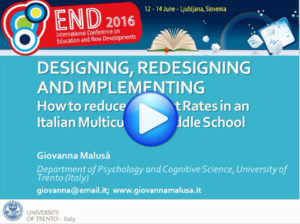 Title: DESIGNING, REDESIGNING AND IMPLEMENTING: HOW TO REDUCE DROPOUT RATES IN AN ITALIAN MULTICULTURAL MIDDLE SCHOOL
Title: DESIGNING, REDESIGNING AND IMPLEMENTING: HOW TO REDUCE DROPOUT RATES IN AN ITALIAN MULTICULTURAL MIDDLE SCHOOL
Submission code: VP_049
Authors: Giovanna Malusà
Abstract: The presence of immigrant students in the Italian school system is now an established reality. Several international and national surveys have highlighted the performance gap between immigrant and non-immigrant students. Underachievement, dropout rates, and ineffective schools are unsolved issues for Italy. The school systems could play a central role in the promotion of authentic intercultural integration, designing real paths towards academic success for all pupils. This paper reports the main results of an Action Research project, conducted from 2011 to 2014 in an Italian middle school with a high proportion (>30%) of students from immigrant backgrounds and/or at risk of dropping out. What are the goals of this longitudinal study? To encourage regular school attendance and to reduce dropout rates through an experimental integration year between middle and high school, combined with innovative, active teaching methodologies. The presentation highlights the strengths and weaknesses of each stage of the process. It focuses on time, space, teaching strategies, and on relationships with parents, other classes in the school and on the school network.
Keywords: Dropouts, equity, immigrant students, multicultural contexts, action research.
File Extension: Windows Media Audio/Video file (.wmv)
 Title: THE ROLE OF HIGHER EDUCATION IN ORGANIZATIONAL SETTINGS
Title: THE ROLE OF HIGHER EDUCATION IN ORGANIZATIONAL SETTINGS
Submission code: VP_058
Authors: Carmine P. Gibaldi
Abstract: The U. S. economic recovery relies on getting high-quality degrees into the hands of a larger, more diverse pool of people. Boards of institutions of higher education can help make higher education more productive by focusing on how to capture efficiencies, deliver instruction in new ways, and work smarter. Boards should ask questions such as: 1) How can our institution target financial incentives to support graduating more students with high-quality degrees? 2) How can it use tuition and financial aid to incentivize students to complete their course work on time? 3) How can it implement low-cost, high-quality delivery approaches? 4) What business efficiencies can it achieve through joint purchasing, back-office consolidation, and other similar approaches? Beyond college completion, colleges and universities should be concerned about learning outcomes. They should charge presidents and chief academic officers with ensuring that student learning is assessed and the data shared with the appropriate stakeholders.
Keywords: Corporate learning, adult learners, workplace.
File Extension: Video Clip (.avi)
 Title: JOINT APPROACHES TO RESEARCHER EDUCATION: INSTITUTIONAL POLICY, TOOLS AND INSTRUMENTS
Title: JOINT APPROACHES TO RESEARCHER EDUCATION: INSTITUTIONAL POLICY, TOOLS AND INSTRUMENTS
Submission code: VP_108
Authors: Ekaterina Kozina
Abstract: This paper presents a set of general guidelines how best to assist small but increasing number of staff / researcher collaborative and transnational partnerships within the context of joint supervision of postgraduate research students. In practice, collaborative partnerships may represent many types of activity, including those of providing a specialized advice within one’s area of expertise, visit to a research lab, students exchanges and placements of varied duration. Research in the 21st century by its very nature is collaborative and academic collaboration whether at national and / or international level are common place. The primary focus and arguments of the paper it focusing not on various forms of collaborative activity, but rather on two types of collaborations – informal (limited) and formalized (extensive) collaborations. A plan (structure / focus) for this paper, includes discussion of i) benefits, risks and costs and nature of supervision of research students across institutions, ii) considerations when entering agreements for the joint supervision of PG research students and, iii) challenges in taking a policy led approach (including loci of decision-making). Against a back-drop of growing EC emphasis on Joint Degree Projects, and internationalization of doctoral candidate experience, this paper presents a policy development initiative and the associated methodology and practical tools (e.g. policy structures, flowcharts, templates) which may assist higher education institutions support, in a sustainable way, collaborative and transnational partnerships for joint supervision of postgraduate research students. Research collaboration whether at national and / or international level is common place. In recent years doctoral education has changed: candidates go to other institutions for laboratory rotations, to undertake graduate training, and to access expertise. Their experience is increasingly mobile and internationalized, fuelled by EC initiatives such as Marie Curie. In parallel, institutions have begun to enter arrangements to jointly deliver programmes (most commonly at Master’s level). Establishing joint degrees is an explicit goal in the Bologna process and EU funding is actively encouraging this model at doctoral level. As a result of these factors, doctoral candidates and their supervisors are increasingly seeking formal, institutional recognition of PhD programmes. Nevertheless, institutional and national commitments to the concepts of joint and double degrees vary significantly, terminology is confused, legal positions uncertain. Underpinning our research is recognition of a need for a University policy led approach, to ensure that faculty and students benefit from jointly engaging in research with collaborators in other institutions, but that risks and costs are appropriately managed. Modes of inquiry/ data sources and evidence: This research paper is based on a case study of the proposal, negotiation and adoption of a policy within the framework of one higher education institution and the development of related guidelines, methodology and practical tools to enable the recognition of joint informal and formalized collaborations at an institutional level. These instruments of university policy facilitate a shared understanding across a University about the extent to which it is desirable to formalize co-supervision arrangements with other institutions, and bring clarity to the context in which a University can support joint supervision and joint award arrangements for research degrees. Results, Conclusions: Why it is timely for a research paper on this chosen topic? Internationalization is a rising phenomenon globally (EC, 11.7.2013:2) and important in the context of Erasmus + in particular, (historically Tempus, Erasmus Mundus and Marie Curie). Against a background of increasing competition and overtures from HEIs in the USA, Asia, the Middle East and Latin America, higher education in Europe needs to be strategic in managing and capitalizing on increasing number of staff / researcher collaborative and transnational partnerships. However, research has indicated that many educational collaborations are unsustainable, and institutions are not clarifying their strategic intent. This paper discussed the approaches to practical instruments and tools relating to management of risk, ensuring academic standards and bringing clarity to the context in which a University can support joint supervision and joint award arrangements for research degrees.
Keywords: Academic collaboration and its types, joint supervision, concepts of joint degrees/awards, postgraduate students, policy approach.
File Extension: Windows Media Audio/Video file (.wmv)
 Title: CAN AN INVESTIGATION OF PROMOTION, RECOGNITION AND TENURE STRATEGIES AND STRUCTURES IDENTIFY STRATEGIES TO PROMOTE SERVICE-LEARNING PEDAGOGY WITHIN THE HIGHER ACADEMIC COMMUNITY?
Title: CAN AN INVESTIGATION OF PROMOTION, RECOGNITION AND TENURE STRATEGIES AND STRUCTURES IDENTIFY STRATEGIES TO PROMOTE SERVICE-LEARNING PEDAGOGY WITHIN THE HIGHER ACADEMIC COMMUNITY?
Submission code: VP_267
Authors: Vibhavari Jani, Dustin Wilgers, Jean Gleichs & Cheryl Rude
Abstract: At most universities in the USA today, a faculty member is expected to be engaged in teaching, research, and service. Each institution’s focus may vary; some universities may place greater emphasis on teaching, while at others focus may be on research. While service activities are appreciated, it may not get as much recognition in a faculty member’s evaluation for tenure and promotion at some universities. Thus promotion of “service-learning pedagogy” becomes challenging. Can this gap be bridged? Can an investigation of promotion, recognition and tenure strategies reveal any insights? Can this investigation lead one in identifying strategies to promote service-learning pedagogy within the higher academic community? Four Kansas Campus Compact (KSCC) Faculty Fellows (henseforth known as the authors) located at four different universities in the state of Kansas undertook a research project to understand how the “scholarship of engagement” (Boyer, 1996) is evaluated at the institutes of higher-learning in Kansas. They started their research by conducting literature reviews on this topic to understand major trends and issues related to promotion of service learning. Based on these reviews, a survey instrument was developed and distributed online to Kansas Campus Compact (KCC) member and non-member institutions. The survey questions were developed to gain insights into how service learning activities are evaluated for promotion and tenure at universities in Kansas. This paper documents the results of their literature reviews. The detailed survey results are published as a separate article given the page limitation of this proceedings.
Keywords: Higher education, service learning pedagogy, tenure evaluation, promotion, scholarship of engagement.
File Extension: MP4 Video (.mp4)
